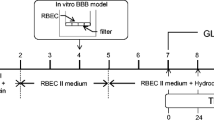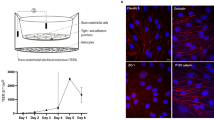Abstract
The internalization of a neuromodulatory adrenocorticotropic hormone (ACTH) analogue, [125I]ebiratide (H-Met(O2)-Glu[125I]His-Phe-D-Lys-Phe-NH(CH2)8NH2), was examined in cultured mono-layers of bovine brain capillary endothelial cells (BCEC). HPLC analysis of the incubation solution showed that [125I]ebiratide was not metabolized during the incubation with BCEC. The acid-resistant binding of [125I]ebiratide to BCEC increased with time for 120 min and showed a significant dependence on temperature and medium osmolarity. Pretreatment of BCEC with dansylcadaverine or phenylarsine oxide, endocytosis inhibitors, and 2,4-dinitrophenol, a metabolic inhibitor, decreased significantly the acid-resistant binding of [125I]ebiratide. The acid-resistant binding of [125I]ebiratide was saturable in the presence of unlabeled ebiratide (100 nM–1 mM). The maximal internalization capacity (B max) at 30 min was 7.96 ± 3.27 µmol/mg of protein with a half-saturation constant (K d) of 15.9 ± 6.4 µM. The acid-resistant binding was inhibited by basic peptides such as poly-L-lysine, protamine, histone, and ACTH but was not inhibited by poly-L-glutamic acid, insulin, or transferrin. These results confirmed that ebiratide is transported through the blood-brain barrier via an absorptive-mediated endocytosis.
Similar content being viewed by others
REFERENCES
T. Terasaki, K. Hirai, H. Sato, Y. S. Kang, and A. Tsuji. Absorptive-mediated endocytosis of a dynorphin-like analgesic peptide, E-2078, into the blood-brain barrier. J. Pharmacol. Exp. Ther. 251:351–357 (1989).
T. Terasaki, Y. Deguchi, H. Sato, K. Hirai, and A. Tsuji. In vivo transport of a dynorphin-like analgesic peptide, E-2078, through the blood-brain barrier: An application of brain microdialysis. Pharm. Res. 8:815–820 (1991).
F. J. Hock, H. J. Gerhards, G. Wiemer, P. Usinger, and R. Geiger. Learning and memory processes of an ACTH4-9 analog (ebiratide; Hoe 427) in mice and rats. Peptides 9:575–581 (1988).
T. Matsumoto, K. Oshima, A. Miyamoto, M. Sakurai, M. Gotoh, and S. Hayashi. Trophic action of α-melanocyte stimulating hormone (α-MSH) and Hoe 427, an adrenocorticotropic hormone (ACTH) analogue, on cultured septal neurons from rat embryos. Neurochem. Res. 14:778 (1989) (abstract).
G. Wiemer, H. J. Gerhards, F. J. Hock, P. Usinger, W. von Rechenberg, and R. Geiger. Neurochemical effects of the synthetic ACTH4-9-analog Hoe 427 (ebiratide) in rat brain. Peptides 9:1081–1087 (1988).
T. Shimura, S. Tabata, T. Ohnishi, T. Terasaki, and A. Tsuji. Transport mechanism of a new behaviorally highly potent adrenocorticotropic hormone (ACTH) analog, ebiratide, through the blood-brain barrier. J. Pharmacol. Exp. Ther. 258:459–465 (1991).
A. K. Kumagai, J. B. Eisenberg, and W. M. Pardridge. Absorptive-mediated endocytosis of cationized albumin and a β-endorphin-cationized albumin chimeric peptide by isolated brain capillaries. J. Biol. Chem. 262:15214–15219 (1987).
D. Triguero, J. B. Buciak, J. Yang, and W. M. Pardridge. Blood-brain barrier transport of cationized immunoglobulin G: Enhanced delivery compared to native protein. Proc. Natl. Acad. Sci. USA 86:4761–4765 (1989).
W. M. Pardridge, D. Triguero, and J. Buciak. Transport of histone through the blood-brain barrier. J. Pharmacol. Exp. Ther. 251:821–826 (1989).
T. Shimura, S. Tabata, and S. Hayashi. Brain transfer of a new neuromodulating ACTH analog, ebiratide, in rats. Peptides 2:509–512 (1991).
T. Terasaki, S. Takakuwa, S. Moritani, and A. Tsuji. Transport of monocarboxylic acids at the blood-brain barrier: Studies with monolayers of primary cultured bovine brain capillary endothelial cells. J. Pharmacol. Exp. Ther. 258:932–937 (1991).
J. B. M. M. van Bree, K. L. Audus, and R. T. Borchardt. Carrier-mediated transport of bacrofen across monolayers of bovine brain endothelial cells in primary culture. Pharm. Res. 5:369–371 (1988).
K. L. Audus and R. T. Borchardt. Characteristics of the large neutral amino acid transport system of bovine brain microvessel endothelial cell monolayers. J. Neurochem. 47:484–488 (1986).
C. Estrada, J. Bready, J. Berliner, and P. A. Cancilla. Choline uptake by cerebral capillary endothelial cells in culture. J. Neurochem. 54:1467–1473 (1990).
B. Draznin, C. C. Solomons, D. R. Toothaker, and K. E. Sussman. Energy-dependent steps in insulin-hepatocyte interaction. Endocrinology 108:8–17 (1981).
B. L. Clarke and P. H. Weigel. Recycling of the asialoglyco-protein receptor in isolated rat hepatocytes: ATP depletion blocks receptor recycling but not a single round of endocytosis. J. Biol. Chem. 260:128–133 (1985).
R. Persson, E. Ahlstrom, and E. Fries. Differential arrest of secretory protein transport in cultured rat hepatocytes by azide treatment. J. Cell Biol. 107:2503–2510 (1988).
W. M. Hunter and F. C. Greenwood. Preparation of iodine-131 labeled human growth hormone of high specific activity. Nature 194:495–496 (1962).
K. L. Audus and R. T. Borchardt. Characterization of an in vitro blood-brain barrier model system for studying drug transport and metabolism. Pharm. Res. 3:81–87 (1986).
S. Meresse, M. P. Dehouck, P. Delorme, M. Bensaid, J. P. Tauber, C. Delbart, J. C. Fruchart, and R. Cecchelli. Bovine brain endothelial cells express tight junctions and monoamine oxidase activity in long-term culture. J. Neurochem. 53:1363–1371 (1989).
C. C. W. Hughes and P. L. Lantos. Uptake of leucine and alanine by cultured cerebral capillary endothelial cells. Brain Res. 480:126–132 (1989).
O. H. Lowry, N. J. Rosebrough, A. L. Farr, and R. J. Randall. Protein measurement with the folin phenol reagent. J. Biol Chem. 193:265–275 (1951).
K. Yamaoka, Y. Tanigawara, T. Nakagawa, and T. Uno. A pharmacokinetic analysis program (MULTI) for microcomputer. J. Pharmacobio-Dyn. 4:879–885 (1981).
H. T. Haigler, F. R. Maxfield, M. C. Willingham, and I. Pastan. Dansylcadaverine inhibits internalization of 125I-epidermal growth factor in BALB 3T3 cells. J. Biol. Chem. 255:1239–1241 (1980).
V. P. Knutson, G. V. Ronnett, and M. D. Lane. Rapid, reversible internalization of cell surface insulin receptors. J. Biol. Chem. 258:12139–12142 (1983).
H. S. Wiley and D. D. Cunningham. The endocytosis rate constant. A cellular parameter for quantitating receptor-mediated endocytosis. J. Biol. Chem. 257:4222–4229 (1982).
K. R. Smith, A. Kato, and R. T. Borchardt. Characterization of specific receptors for atrial natriuretic factor on cultured bovine brain capillary endothelial cells. Biochem. Biophys. Res. Commun. 157:308–314 (1988).
H. J. L. Frank and W. M. Pardridge. A direct in vitro demonstration of insulin binding to isolated brain microvessels. Diabetes 30:757–761 (1981).
W. M. Pardridge, J. Eisenberg, and J. Yang. Human blood-brain barrier transferrin receptor. Metabolism 36:892–895 (1987).
T. Mitsuma, Y. Hirooka, T. Maeda, S. Tabata, and S. Hayashi. Radioimmunoassay of an analogue of adrenocorticotropic hormone, H-Met(O2)-Glu-His-Phe-D-Lys-Phe-NH(CH2)8-NH2 (ebiratide). J. Xenobiot. Metab. Dispos. 5:323–330 (1990).
A. W. Vorbrodt, A. S. Lossinsky, D. H. Dobrogowska, and H. M. Wisniewski. Distribution of anionic sites and glycoconjugates on the endothelial surfaces of the developing blood-brain barrier. Dev. Brain Res. 29:69–79 (1986).
J. Leonis and C. H. Li. Corticotropins (ACTH). XII. Acid-base equilibria of α-corticotropin and bovine corticotropin. J. Am. Chem. Soc. 81:415–419 (1959).
W. A. Banks, A. J. Kastin, and C. M. Barrera. Delivering peptides to the central nervous system. Dilemmas and strategies. Pharm. Res. 8:1345–1350 (1991).
Author information
Authors and Affiliations
Rights and permissions
About this article
Cite this article
Terasaki, T., Takakuwa, S., Saheki, A. et al. Absorptive-Mediated Endocytosis of an Adrenocorticotropic Hormone (ACTH) Analogue, Ebiratide, into the Blood–Brain Barrier: Studies with Monolayers of Primary Cultured Bovine Brain Capillary Endothelial Cells. Pharm Res 9, 529–534 (1992). https://doi.org/10.1023/A:1015848531603
Issue Date:
DOI: https://doi.org/10.1023/A:1015848531603




